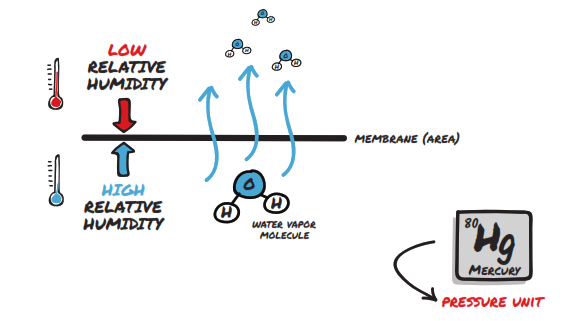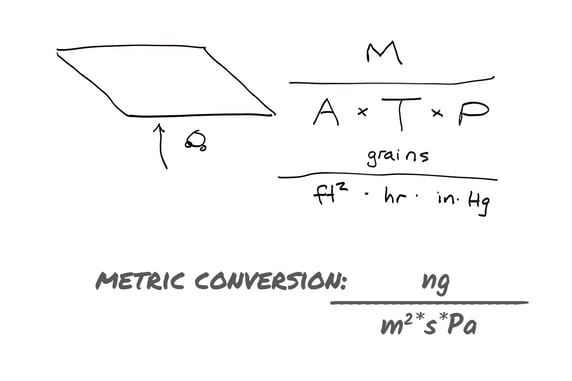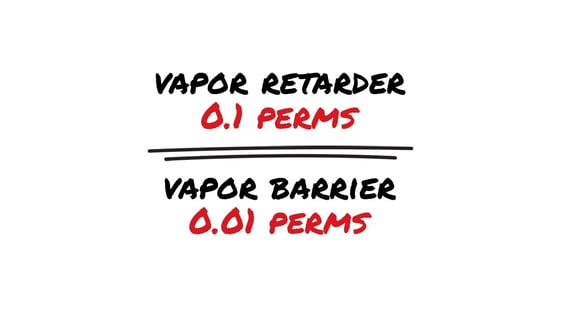STEGO IQ | Below-Slab Vapor Barriers: What Does a Perm Rating Mean?
STEGO IQ is a new video series focused on providing technical knowledge as it relates to the construction industry. In this first episode, Dan Marks, Stego Technical Director, defines permeance, and how perm ratings from test methods are critical to building materials, such as vapor barriers and retarders.

Video Transcription
You’re looking at a data sheet: so what is a ‘perm?’ This is Stego IQ.
What is Permeance Rating?
A perm is a unit that we use to measure the permeance rating of under-slab vapor barriers and retarders. It’s equal to a mass unit diffusing across a membrane – a mass of water vapor per a given area, per a given amount of time, being spurred by a vapor pressure differential.
Specifically, the U.S. perm unit is a grain of water – which again, is a mass unit equal to one 7,000th of a pound – per square foot, per hour, per inch of mercury pressure differential (metric conversion: ng/m2*s*Pa). An inch of mercury is really just a pressure unit. It could’ve been pascals, it could’ve been pounds per square inch, we decided as an industry to use inches of mercury.

When a molecule of water vapor wants to diffuse across a membrane, it’s doing so because of a difference in vapor pressure. Diffusion is really spurred by concentration difference. In this case, we can quantify that by looking at a vapor pressure differential. If the relative humidity and temperature on either side of the membrane were identical, we wouldn’t have the vapor drive, so to speak. We wouldn’t have that force or difference in pressure. When we have differences in the combination of relative humidity and temperature, we have the difference and we have a vapor pressure differential: we can measure and plug into the unit and measure how much moisture is going to move across a given membrane
How to Calculate a Permeance Rating
Let me show you an example.

A U.S. perm unit, again, is going to measure the diffusion of water vapor across a membrane. We’re looking at a mass transport or diffusion of water across a given area over a given amount of time, based on a differential in pressure on either side of a membrane. Specifically, in terms of the units, we’re looking at grains per square foot, per hour, per inch of mercury (metric conversion: ng/m2*s*Pa), again this representing the pressure differential.
The Importance of Permeance Rating in Regards to Below-Slab Vapor Barriers
So why is this important? Why do we care about the units, and more specifically – why do we care about the permeance rating?

Permeance ratings help us to distinguish between classifications – or levels of protection – for underslab vapor barriers and retarders. In fact, a vapor retarder is typically a material that’s considered to have a permeance of 0.1 perms or less. A vapor barrier, on the other hand, has been distinguished within the industry of having a permeance of 0.01 perms or less – an order of magnitude lower.
This is critical for instances where we have moisture-sensitive floor covering materials or we potentially may have that down the road and provide an owner with additional flexibility. It’s really important in general when we want to be keeping excess moisture – or at least unchecked moisture – out of our building interiors and indoors.
Continue to Build Your Brain With Stego IQ
Keep learning: build your brain and your knowledge. You can view more educational videos on Stego IQ topics on stegoindustries.com.
- Stego (26)
- StegoCrawl (24)
- Stego-Awareness (17)
- StegoHome (15)
- Case Studies (14)
- StegoCrawl-Consideration (12)
- StegoCrawl-Awareness (11)
- Customer Stories (9)
- Stego-Consideration (9)
- Pango (8)
- StegoHome-Consideration (8)
- Beast (7)
- How to Install (7)
- StegoHome-Awareness (7)
- Drago (5)
- Pango-Awareness (5)
- Beast-Awareness (4)
- Beast-Consideration (3)
- Drago-Awareness (3)
- Pango-Consideration (3)
- Stego IQ (3)
- Drago-Consideration (2)
- StegoCrawl-Decision (2)
Popular Posts
Stay Connected.
Enter your email below.








Post Comments